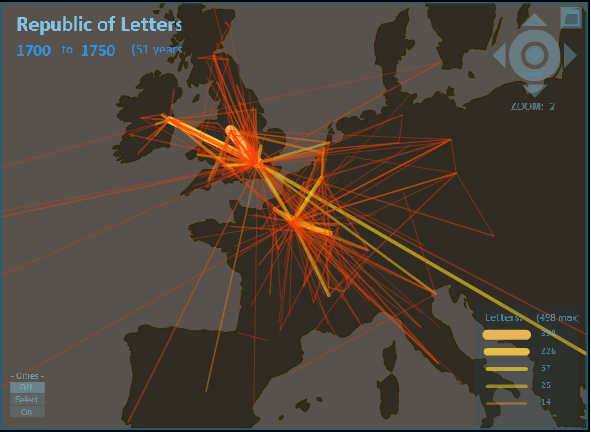The following post is crossposted from the OpenGLAM blog, and is about Stanford’s Mapping the Republic of Letters Project – one of the finest examples of what can be done with cultural heritage data and open source tools. Mapping the Republic of Letters is a collaborative, interdisciplinary humanities research project looking at 17th and 18th century correspondence, travel, and publication to trace the exchange of ideas in the early modern period and the Age of Enlightenment.
What unites the researchers involved in Mapping the Republic of Letters is the opportunity to explore historical material in a spatial context and ask big-data questions across archives: Did the Republic of Letters have boundaries? Where was the Enlightenment?
The Republic of Letters is an early modern network of intellectuals whose connections transcended generations and state boundaries. It has been described as a lost continent and debate continues about whether or not it really existed. Though the ‘letters’ of the title refers to scholarly knowledge, epistolary exchange was, in fact, the net that held this community together. Letters could be shipped around the world and shared across generations. Among our case studies, Athanasius Kircher’s correspondence network was the most widely distributed, exchanging letters with Jesuit outposts from Macau to Mexico.
Since the early stages of our project, we used open-source graphics libraries to visualize our collected data. The first step is to understand the ‘shape’ of the archive. A timeline + histogram, for example, reveals at a glance the distribution of letters in the collection over hundreds of years. And the map connecting cities as source and destination of sent letters reveals geographic “cold-spots” as well as hot-spots in the archive.
As we begin to dive in and pursue specific research questions, visualization tools in the form of maps, network graphs and charts, help us to make sense of piles of data all at once. Voltaire’s correspondence alone includes about 15,000 letters. Putting those letters on a map instantly gives us a picture of where Voltaire traveled and reveals temporal and spatial patterns in his letter-writing. And while there is no record of epistolary exchange between Voltaire and American inventor and statesman, Benjamin Franklin, a network graph of their combined correspondence quickly reveals three second degree connections.

One outcome of this project is a visualization layer to complement the well-established text-based search model for archives. To begin to really piece together a map of the Republic of Letters, we need to find a way to thread a path through the many dispersed and otherwise silo-ed correspondence archives. Another great challenge is to visually reflect the gaps, uncertainty and ambiguity in the historical record. It is often those gray areas that provide new research opportunities for humanists. In this effort we are very pleased to be working in partnership with DensityDesign Research Lab in Milan.
We have also been working closely with the Cultures of Knowledge project at Oxford. Cultures of Knowledge recently released a beta version available of their open access union catalog of early modern letters, aptly named Early Modern Letters Online. Their model is not to be the repository, but to provide a rich search layer across existing correspondence collections pointing back out to the source repository. Our friends at the Dutch 17th Circulation of Knowledge project are addressing the challenges of mining early modern correspondence for topics across many languages.
The code-base for our visualizations is open source and available for download at athanasius-project.github.com. Our code-base is available, but that is not to say that our visualizations are pret-a-porter. Since our research is devoted to knowledge production in the humanities and not software development, the code is rather idiosyncratic and constrained by our changing data model. Please contact us if you would like to learn more or would like to join the effort.
Nicole Coleman is head of the Stanford Humanities Center Research Lab and co-investigator of Mapping the Republic of Letters.









